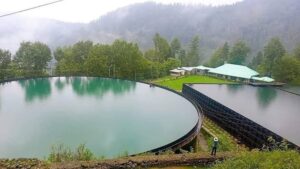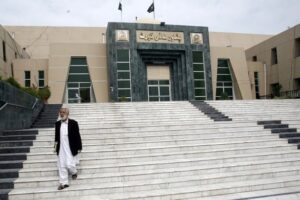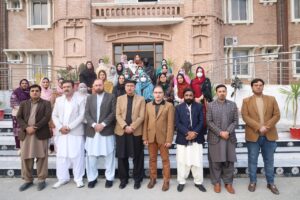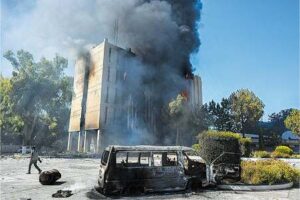On the outskirts of Peshawar, past the relentless honking of rickshaws and the chaos of Saddar’s crumbling colonial-era facades, lies Gora Qabristan, a cemetery that few care to notice.
The iron gate, rusted and clinging to its hinges, swings open to reveal an overgrown landscape—headstones tilted at odd angles, inscriptions fading, histories vanishing. This is Gora Qabristan, a relic of the British Raj, where the empire’s dead rest in uneasy silence.
At first glance, it looks like any other neglected burial ground, swallowed by urban sprawl. But step closer, and the stories begin to reveal themselves—names carved into stone, dates marking lives lost to war, disease, or forgotten misfortunes. Each grave, a thread in the fabric of colonial history.
The British arrived in Peshawar not as visitors but as conquerors, staking their claim in a city that had long been a crossroads of empires. With their forts and cantonments came a need for burial grounds—final resting places for the officers and soldiers who would never return home.
Established in 1853, Gora Qabristan was once a meticulously maintained cemetery, its boundaries marked by an imposing wall, its paths shaded by acacia and neem trees. Over time, though, the cemetery suffered the same fate as much of the British-era infrastructure in Pakistan—neglect, encroachment, decay. Today, its gravestones tell of violent encounters with Afghan tribes, deaths from tropical fevers, and the occasional tragedy of young officers perishing far from home.
One such grave belongs to Lieutenant George Richmond, killed in 1863 during a skirmish in Swat, a conflict that cost the British nearly a thousand lives. Another marks the final resting place of Isidore Loewenthal, a Jewish convert to Christianity who spent his life translating the Bible into Pashto—until his own guard turned against him in 1864. A few yards away, the gravestone of Sir Richard Warburton stands, weathered by time. Warburton, an officer of the East India Company, had married into Afghan royalty, his wife a niece of Amir Dost Mohammad. His son, lRobert Warburton, would go on to form the legendary Khyber Rifles, a regiment tasked with guarding the empire’s volatile frontier. But not all the dead here were soldiers.
There are entire sections dedicated to railway workers who perished building the ill-fated Shalman Railway Line, an ambitious but doomed attempt to extend British infrastructure into the mountains. And then there are those who fell to a more invisible enemy—an outbreak of influenza that swept through British India in the early 20th century, leaving dozens of graves marked with dates just days apart.
Cemeteries of the frontier
The British were meticulous planners, ensuring that their dead were interred with dignity—even on the fringes of empire. In Peshawar alone, they built at least four cemeteries, each corresponding to a different phase of colonial expansion. The earliest, dating back to 1842, was located near Wazir Bagh, though little remains of it today. Another, behind what later became the State Bank of Pakistan, was formally recognized by the Bishop of Madras in 1857, only to be lost to urban development. But it was Gora Qabristan, near Tehkal Gate, that became the most enduring of these colonial burial grounds. Situated along the road leading to Afghanistan, it held the remains of officers killed in the Anglo-Afghan Wars, as well as civilians who had made Peshawar their home.
For decades, the cemetery was a landmark of the Raj. The British bishop Matthewonce described it as “one of the most beautiful church cemeteries in the Punjab plains.” Even today, its old trees stand defiant, casting long shadows over graves marked with Pashto inscriptions—a testament to the city’s layered history. Some of these graves hold stories of love and devotion. One, in particular, belongs to an English couple, buried side by side. The tale goes that when a British forest officer lost his wife in Peshawar, he swore never to be separated from her, even in death. Years later, when he passed away in England, his body was brought back across continents to be laid to rest beside her.
The forgotten Parsis of Peshawar
Beyond the Christian cemeteries, another burial ground lies tucked away in the heart of the old city—a remnant of a once-thriving Parsi community. During the British era, Peshawar’s cantonment had attracted traders and businessmen from across India. Among them were the Parsis, a community of fire-worshippers from Bombay, Karachi, and Calcutta, who built thriving commercial enterprises here. But as their numbers dwindled, so did the memory of their presence. Their cemetery, established in 1860 on what is now Sunehri Masjid Road, is the last of its kind in Khyber Pakhtunkhwa. Once positioned at the southern edge of Peshawar Cantonment, it has since been swallowed by the city’s relentless expansion. Today, few know of its existence, let alone the names etched onto its tombstones.
A history erased
The cemeteries of Peshawar are disappearing—not just physically, but from public consciousness. Encroachments have eaten away at their boundaries, while newer graves are dug atop older ones without record or ceremony. Many of the headstones that once bore intricate engravings now stand defaced, their inscriptions eroded by time or carelessness.
In a city as ancient as Peshawar, histories overlap, and memories fade. But the silence of these cemeteries is deceptive. Beneath the soil, the past lingers—waiting, perhaps, for someone to listen before it vanishes altogether.
Also Read:
Kandar Badadi excavation: Tracing 2,000 Years of Civilization in Hazara












